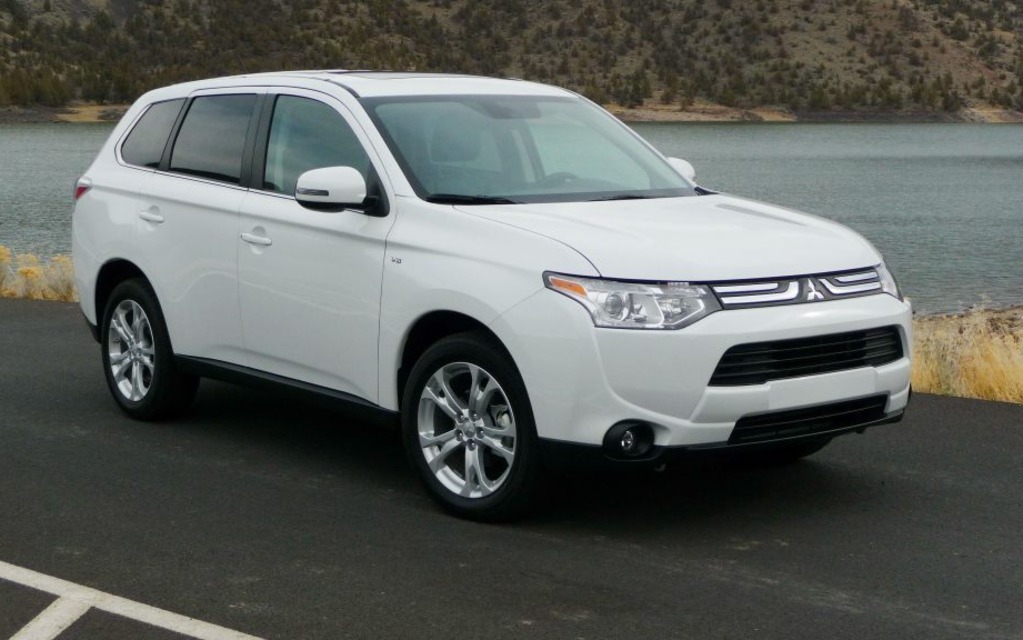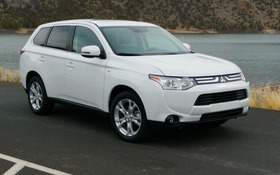2014 Mitsubishi Outlander: Conservative exterior, sophisticated mechanics

| Strong points |
|
|---|---|
| Weak points |
|
You don’t have to be an automobile expert to know that Mitsubishi does not exactly dominate the North American market. In recent years, the company has significantly reduced the number of models in its line and even though their sales have been slowly climbing, there’s still plenty of room for improvement. Yet, things may be looking up for this automaker, as the American automobile market is on the mend and new car sales have increased in Canada, too.
With hope on the horizon, Mitsubishi is preparing to launch two new models: a compact SUV and a sub-compact sedan. The Japanese firm recently lifted the veil off an all-new Outlander, which is expected to play a pivotal role in the manufacturer’s renewed efforts in Canada. It’s expected to roll into dealerships in June. Not only does the Outlander boast impressive sales figures, but its category is experiencing spectacular success. Given that the competition has refreshed their vehicles in recent months, Mitsubishi essentially had no choice but to respond with an Outlander that features improved style and technical specs. Opinion, however, is split on just how elegant this conventionally styled vehicle really is.
- Also: Mitsubishi Offers Customized SUVs for Outdoor Enthusiasts
- Also: Mitsubishi Will Show Their Outlander PHEV Concept In Paris
A step backward?
To be honest, I was stunned when this new model was unveiled at the 2012 Geneva Motor Show. Expecting a more modern exterior, I was surprised to see that the vehicle’s stylists had essentially revived the 2007 model. Sure, a few modifications had been made here and there, but the front section is relatively unchanged. The grille is made up of chrome bars with the Mitsubishi icon sitting front and centre. The air intake, however, is now larger and higher than before. The tail end is also conservative in its appearance, with the only eye-catching element being the chrome strip under the rear window. Note that the contouring around the wheel wells is down to almost nil. I can’t say I was impressed at first glance, though the vehicle does look more elegant out on the road.
The most notable improvement is the all-new dashboard. Not only are the numerous plastic panels gone, but the quality of the materials is now much better. The mechanism for the third row of seats has also been improved, making it easier to use and more comfortable than before. Legroom, however, remains limited. The addition of a power liftgate (on some trims) forced the manufacturer to ditch the two-part hatch seen on the previous model. This decision also helped slash the vehicle’s weight and it is now 100 kg lighter.
Improved platform and engines
Mitsubishi engineers opted to keep many of the mechanical parts from the old model, which makes sense since the Outlander scored reasonably well in this area. However, they did improve its rigidity by using higher quality steel that is not only more rigid but also lighter. The suspension was adjusted for improved road handling. They also chose to keep the same engines and simply modify them. The 2.4-litre four-cylinder now features single overhead camshaft technology. The MITEC continuously variable valve timing system is more efficient than the dual overhead cam used in the past. It makes the engine lighter and simpler while contributing to better fuel economy. The only gearbox available with this mill is a new CVT INVECS-III that offers better accelerations and is also supposed to be less noisy – though if it is, the difference is hard to tell. According to Mitsubishi, this engine’s average fuel consumption is 7.3 L/100 km.
The return of the 3.0-litre V6 will be applauded by drivers who want to tow a small trailer or boat. Thanks to several internal modifications, a revamped exhaust system and a more efficient catalytic converter, this engine should now cost you less at the pump. Mitsubishi claims that its average fuel consumption is 8.8 L/100 km. The V6 is paired with a six-speed automatic transmission. All trims equipped with the V6 engine come with wheel-mounted paddle shifters.
Mechanically and technically sophisticated
Given that the current Outlander is recognized for its excellent all-wheel drive, the base elements of this system have been kept and improved. The basic version is called All-Wheel Control (AWC) and comes with Auto and Lock modes, in addition to the new 4WD Eco, which allows four-wheel drive while saving on fuel. Most of the time, the vehicle transmits power to the front wheels, though this shifts to all four wheels when traction is less than optimal. Meanwhile, the Super All-Wheel Control system (S-AWC) manages the traction of all four wheels, using the brakes and engine torque to prevent slippage. This mechanism is offered factory standard on the GT S-AWC trim.
The Outlander outpaces many other SUVs in its category by offering a wide range of driver assistance programs, including Forward Collision Mitigation, which can bring the vehicle to a full stop when an obstacle is detected in its path, provided it’s going under 30 km/h.
A highly competitive model
True, many people have criticized the 2014 Outlander’s appearance. And true, many others had hoped for more significant mechanical changes. But, at the end of the day, a vehicle’s true value boils down to its performance on the road. This is where I have to admit that Mitsubishi has come out with a well-balanced model that offers excellent handling. Roll on corners is hardly perceptible, while the steering is precise and not overly assisted. The 166-hp four-cylinder engine may not be much of a powerhouse in Eco mode, but its accelerations meet the category average when that mode is deactivated. If you’re not amenable to CVTs, expect to be disappointed, however, as this is the only type of gearbox available with this engine. The V6 is more vigorous with 227 horsepower. The Outlander’s towing capacity – about 3,500 lbs. (1,587 kg) is undeniably an asset.
As the saying goes, don’t judge a book by its cover. When I first saw this vehicle’s somewhat retro exterior, I thought that Mitsubishi had taken a big step in the wrong direction. But now thatI have driven all the new Outlander trims, I can safely say that it can hold its own against most of its competitors. It performs very well in off-road conditions, too.
Come summer 2014, the Canadian Outlander line will welcome the Plug-In Hybrid (which is already available in Japan).











